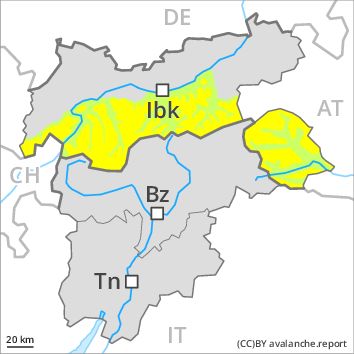Regions
Weißkugel Range, Gurgler Range, Central Stubai Alps, Silvretta, Northern Zillertal Alps, Samnaun Mountains, Venediger Range, Northern Oetz and Stubai Alps, Eastern Rieserferner Mountains, Western Tuxer Alps, Glockner Range, Eastern Tuxer Alps, Eastern Deferegger Alps, Schober Mountains, Lienzer Dolomites, Glockturm Range

Danger level
Avalanche Problem
Gliding snow above 2600m, E-SE-S-SW-W
Wind-drifted snow above 2200m, N-NE-E-W-NW

Fresh wind slabs require caution.
The fresh wind slabs must be evaluated with care and prudence in particular on west to north to southeast facing aspects, in particular in gullies and bowls, and behind abrupt changes in the terrain. At high altitudes and in high Alpine regions avalanche prone locations are more prevalent. Individual gliding avalanches are possible, even quite large ones, especially in the regions with a lot of snow below approximately 2600 m. Areas with glide cracks are to be avoided as far as possible.
Snowpack
dp 6: cold, loose snow and wind
dp 2: gliding snow
At high altitudes and in high Alpine regions the wind was strong to storm force in some cases. As the day progresses the wind slabs have increased in size moderately. The fresh wind slabs are clearly recognisable to the trained eye. They are mostly rather small but can in some cases be released easily. The older wind slabs have bonded quite well with the old snowpack. Faceted weak layers exist deep in the old snowpack above approximately 2800 m. The snowpack will be moist below the tree line.
Tendency
Moderate, level 2.
